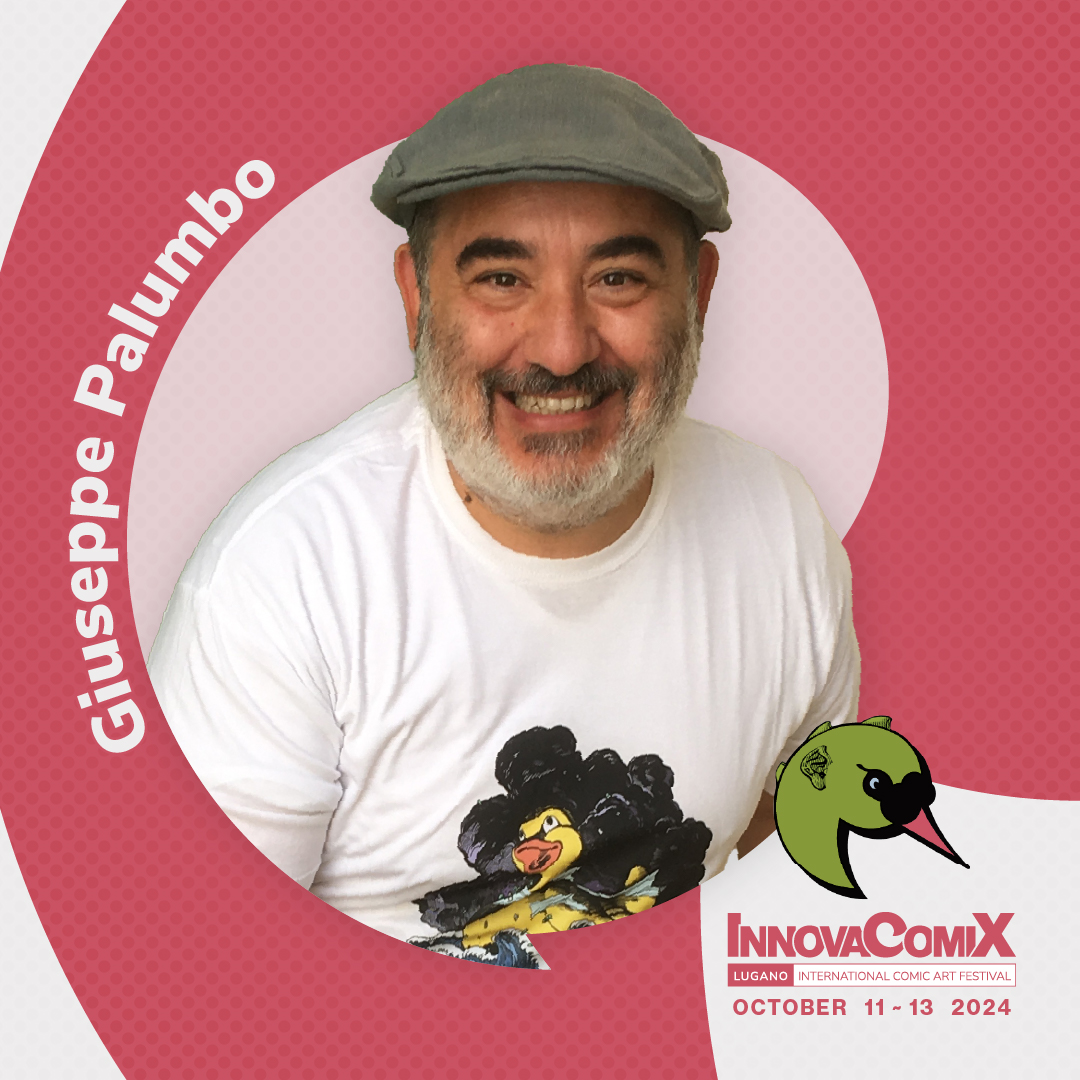“Il fumetto è il linguaggio più libero e anarchico che esista” ci racconta Giuseppe Palumbo. Basta una matita, un foglio di carta, e il mondo prende forma: magari imperfetto, ma sempre pieno di forza. È con questo spirito che l’artista, da sempre, costruisce universi: accessibili, complessi, profondamente umani.
Nato a Matera nel 1964, il suo esordio arriva nel 1986, sulle pagine ribelli di Frigidaire. Qui nasce Ramarro, il suo primo personaggio: un supereroe masochista, fragile e invincibile allo stesso tempo, che non teme il dolore, anzi lo sfida. In un’epoca segnata dalla Guerra Fredda e da disastri naturali come Chernobyl, Ramarro si ispira ad un mondo che crede di poter sfidare ogni equilibrio e ogni limite, nella speranza, illusoria, che ci sia sempre un’altra chance: il suo superpotere, infatti, è una coda che si rigenera ogni volta che viene recisa. Con la stessa energia, Palumbo ha continuato a esplorare territori diversi, raccontando storie che parlano di politica, di erotismo, ma anche di storia e di attualità. Le sue opere hanno varcato i confini, venendo tradotte in più lingue, dal francese al greco fino al tamil. Nel campo dell’illustrazione, ha lavorato con alcune delle case editrici più importanti, tra cui Mondadori, Feltrinelli, Einaudi e Minerva. E non solo: la sua penna si è anche prestata ad alcuni tra i più celebri personaggi del fumetto italiano. Nel 1992 entra nello staff di Martin Mystère della Sergio Bonelli Editore e da allora, ma ha curato anche delle edizioni speciali per Diabolik e Tex. È stato proprio con un albo speciale di quest’ultimo che Palumbo si è aggiudicato il Cygne d’Or per il miglior disegno nell’edizione 2024 del Festival Internazionale del Fumetto Innovacomix.
Alla Basilicata, la sua terra, ha sempre dedicato una parte speciale della sua arte. Non come nostalgico ricordo, ma come impegno concreto: raccontarla al mondo. Che si tratti di storie pubblicate su Topolino, o di veri e propri romanzi storici a fumetti, come La sola cura (Oblomov, 2024), Palumbo scava nella memoria lucana per dare volti e voci a storie sconosciute. Forse non si tratta di un caso, visto che il suo primo amore è stato proprio lo scavo: laureato in archeologia medievale, Palumbo affronta ogni suo fumetto come un archeologo. Strato dopo strato, frammento dopo frammento, ricostruisce non solo storie individuali, ma il senso stesso del nostro passaggio nel tempo. È così che nascono opere come L’elmo e la rivolta — un vero e proprio saggio di critica storica a fumetti — o come Escobar – El Patrón, o ancora Il cavo e il pieno, dedicato a Vincenzo Vela. Come un archeologo del fumetto, Giuseppe Palumbo continua a scoprire mondi nascosti e a restituirceli, con la forza e la poesia della sua penna.
“Comics are the freest and most anarchic form of expression that exists” says Giuseppe Palumbo. All you need is a pencil and a sheet of paper, and the world takes shape: perhaps imperfect, but always full of strength. It is with this spirit that the artist has always built universes: accessible, complex, deeply human.
Born in Matera in 1964, he made his debut in 1986 in the rebellious pages of Frigidaire. This is where Ramarro, his first character, was born: a masochistic superhero, fragile and invincible at the same time, who does not fear pain but challenges it. In an era marked by the Cold War and natural disasters such as Chernobyl, Ramarro is inspired by a world that believes it can challenge every balance and every limit, in the illusory hope that there is always another chance: his superpower, in fact, is a tail that regenerates every time it is cut off. With the same energy, Palumbo has continued to explore different territories, telling stories that speak of politics and eroticism, but also of history and current affairs. His works have crossed borders, being translated into several languages, from French to Greek to Tamil. In the field of illustration, he has worked with some of the most important publishing houses, including Mondadori, Feltrinelli, Einaudi and Minerva. And that’s not all: his pen has also lent itself to some of the most famous characters in Italian comics. In 1992, he joined the staff of Sergio Bonelli Editore’s Martin Mystère but he also edited special editions for Diabolik and Tex. It was with a special issue of the latter that Palumbo won the Cygne d’Or for best drawing in the 2024 edition of the Innovacomix International Comics Festival.
He has always dedicated a special part of his art to his homeland, Basilicata. Not as a nostalgic memory, but as a concrete commitment: to tell its story to the world. Whether in stories published in Topolino, or in actual historical comic novels, such as La sola cura (Oblomov, 2024), Palumbo delves into the memory of Basilicata to give faces and voices to unknown stories. Perhaps this is no coincidence, given that his first love was archaeology: with a degree in medieval archaeology, Palumbo approaches each of his comics like an archaeologist. Layer by layer, fragment by fragment, he reconstructs not only individual stories, but the very meaning of our passage through time. This is how works such as L’elmo e la rivolta (The Helmet and the Revolt) — a veritable essay in historical criticism in comic book form — or Escobar – El Patrón, or Il cavo e il pieno (The Empty and the Full), dedicated to Vincenzo Vela, came into being. Like a comic book archaeologist, Giuseppe Palumbo continues to discover hidden worlds and bring them back to us with the power and poetry of his pen.

